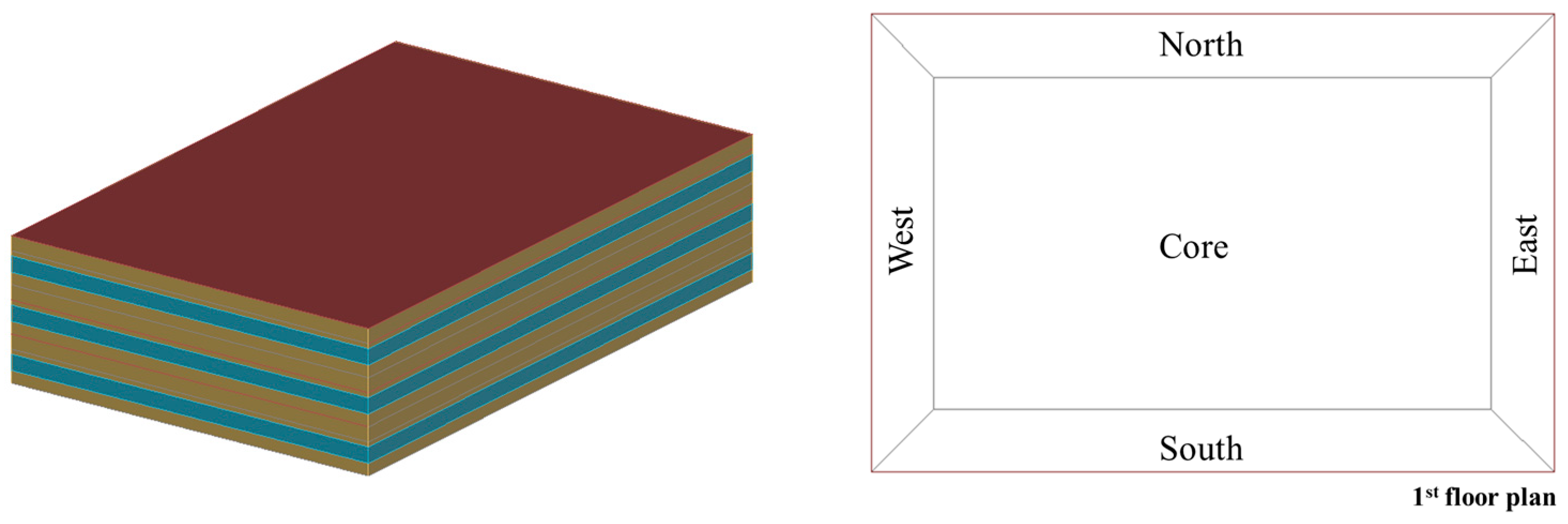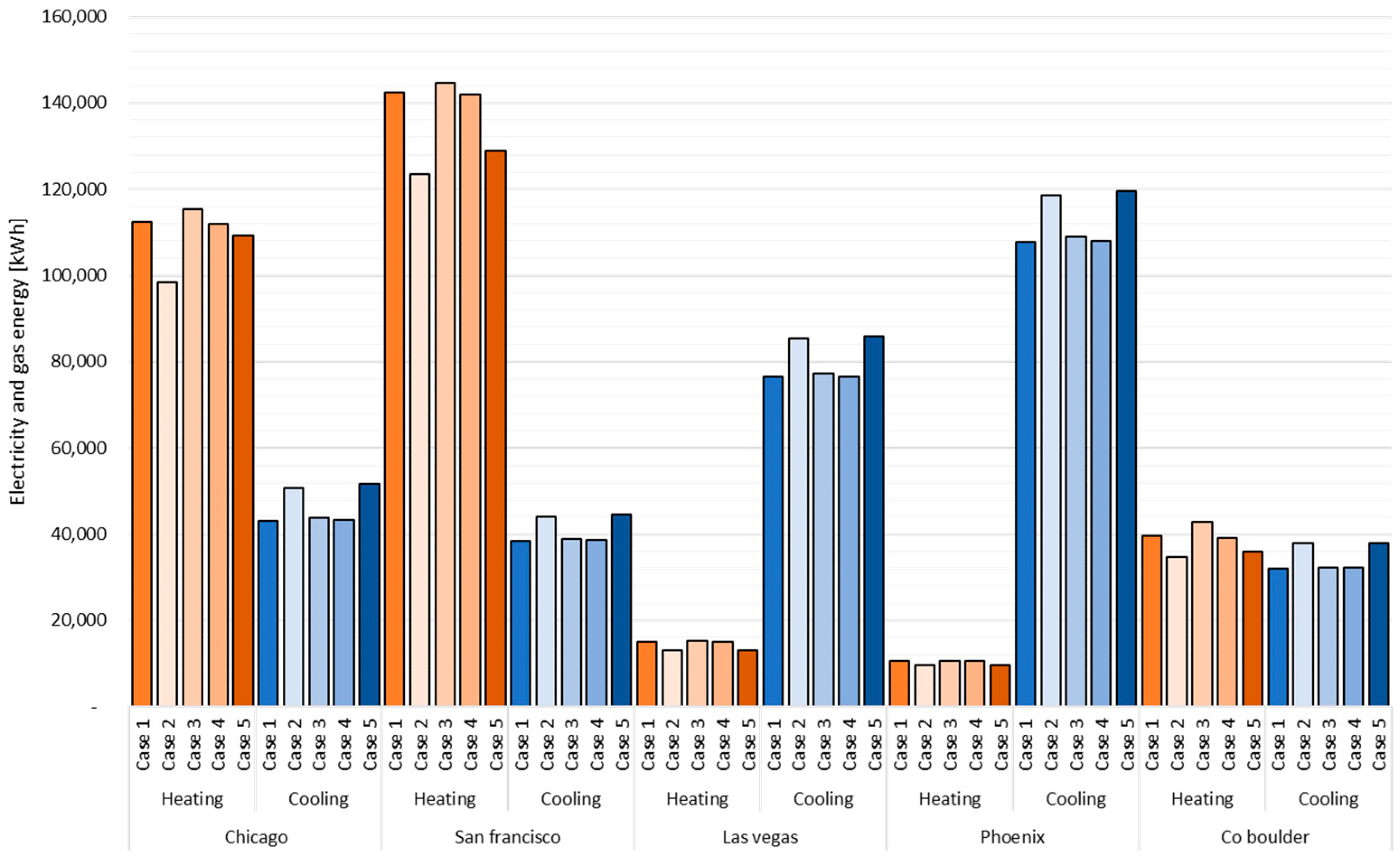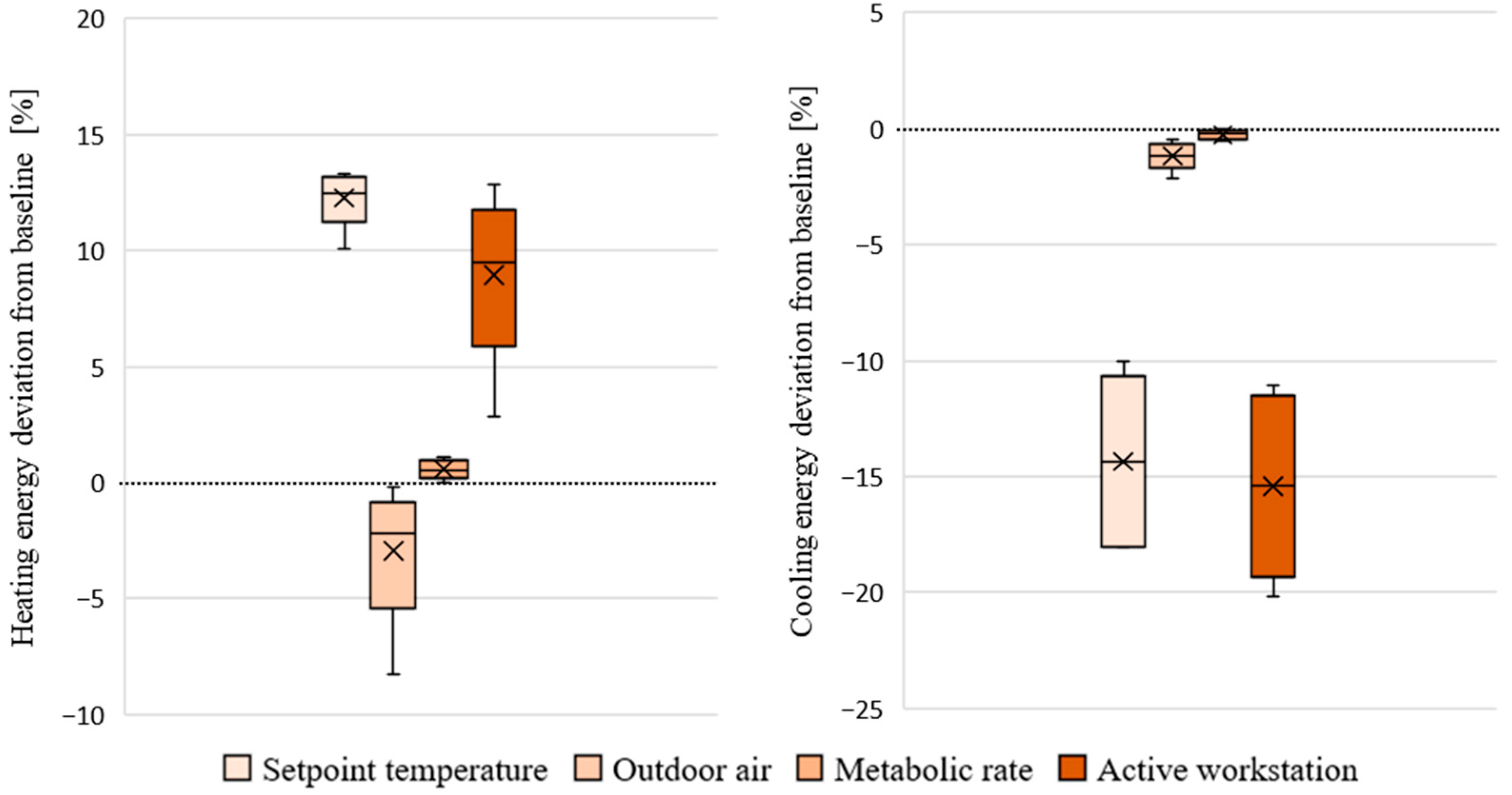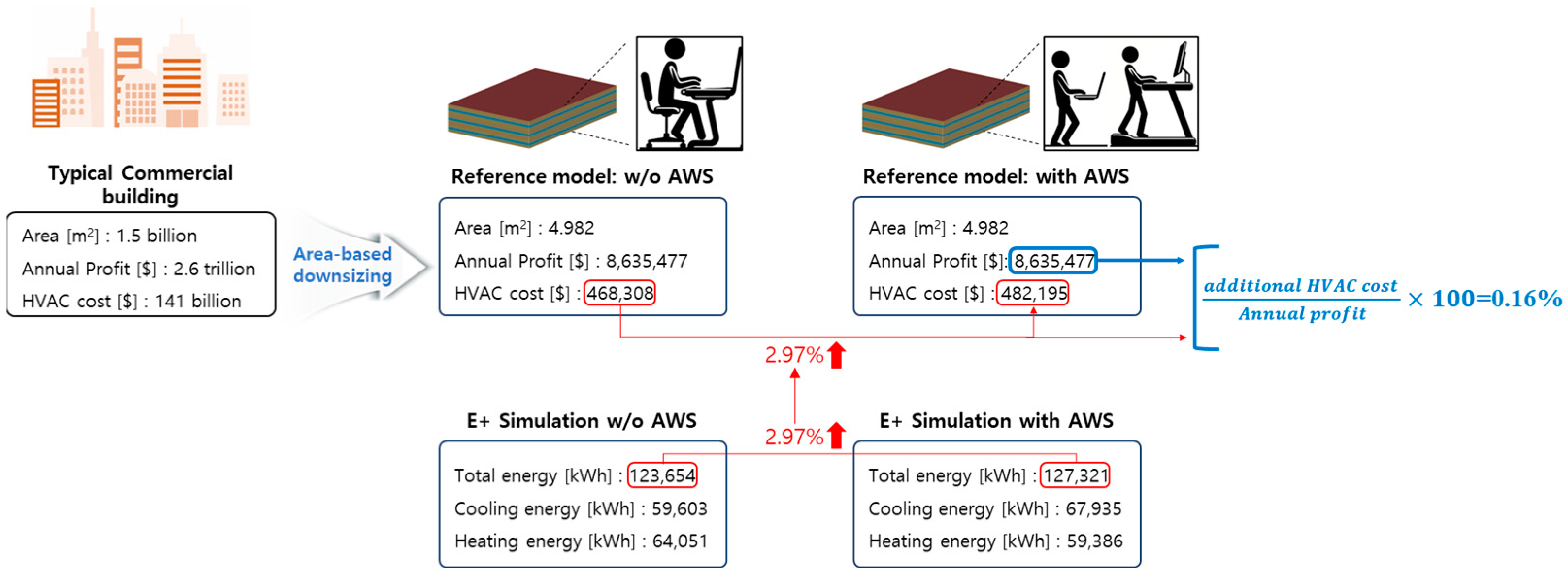Investigation of Energy Consumption of Office Spaces with Active Workstations
Abstract
:1. Introduction
1.1. Background
1.1.1. Overview of Active Office Environment
1.1.2. Recent Trends for Active Office Environment
1.2. Literature Review
1.2.1. Desired Temperature in Activity-Based Flex Office
1.2.2. Impact of Activity-Based Flex Office on Building Energy Consumption
1.2.3. Energy Simulation Tools
1.2.4. Reference Building Models
1.3. Objectives
2. Methodology
2.1. Scope of This Study
2.2. Simulation Tool
3. Evaluation with Building Energy Simulation
3.1. Simulation Settings
3.2. Simulation Results and Analysis
3.3. Cost Analysis
4. Conclusions and Discussion
- Variables including setpoint temperature, outdoor air requirement, and metabolic rate were found to have different impacts on energy consumption.
- Implementing the active workstation, heating energy is decreased, while cooling is increased. The average variation from the simulation results for different cities was found to be 7.28% decreased heating and 14.28% increased cooling, respectively.
- The augmented cost from active workstations is negligible. It comprises about 0.16% of the annual operating profit of the commercial building.
- Addressing a growing trend: The adoption of active workstations in office environments is an emerging trend, propelled by the need to mitigate health risks associated with sedentary lifestyles and improve work performance. Our study aligns with this shift in office culture and provides insights into how it influences energy consumption of the HVAC operations.
- Balancing benefits and energy costs: While the health benefits and improved work performance of active workstations are well-documented, their impact on energy consumption was less understood. Our study addresses this gap by quantifying the energy implications of these workstations, offering a practical perspective for businesses, building designers, and engineers to balance health benefits and improved work performance with energy efficiency.
- Informing policy: The comprehensive analysis of energy consumption patterns in offices with active workstations offers valuable data for policymakers. This information is crucial for developing strategies that optimize energy use while fostering healthier work environments. However, this optimized design and configuration, along with the appropriate policy, might need more health-related data collected from the workers over a long-term period. To gear the research in this direction, a more interdisciplinary approach involving various experts from different domains is required. This study is one of the initial steps for this research vision.
- Economic feasibility: The additional cost incurred from implementing active workstations is relatively small, amounting to about 0.16% of a commercial building’s annual operating profit. This finding highlights the economic feasibility of adopting active workstations, considering their health benefits. Therefore, this study provides a foundation for future research and practical applications in designing healthier and more energy-efficient office environments. However, the additional cost for implementing the active workstation needs to be considered when investigating the economic applicability compassing the life cycle cost or life cycle assessment.
- Limitations on analysis: This study applied synthetic schedules for active workstations based on assumptions. Moreover, the thermal performances of reference building models with different weather profiles might not be representative. Lastly, the economic analysis with the simulation results is based on a rough approximation from public data. Downsizing from a typical commercial building to a reference simulation model was conducted based on the total floor area, which entails an approximation. Therefore, the results of this study might be limited in their capacity to provide useful insight to researchers and practitioners potentially involved in active workstations.
Author Contributions
Funding
Institutional Review Board Statement
Informed Consent Statement
Data Availability Statement
Conflicts of Interest
References
- Physical Activity Guidelines Advisory Committee Scientific Report. Available online: https://health.gov/sites/default/files/2019-09/PAG_Advisory_Committee_Report.pdf (accessed on 27 July 2023).
- Carlson, S.A.; Fulton, J.E.; Pratt, M.; Yang, Z.; Adams, E.K. Inadequate Physical Activity and Health Care Expenditures in the United States. Prog. Cardiovasc. Dis. 2015, 57, 315–323. [Google Scholar] [CrossRef] [PubMed]
- Sawyer, A.; Smith, L.; Ucci, M.; Jones, R.; Marmot, A.; Fisher, A. Perceived office environments and occupational physical activity in office-based workers. Occup. Med. 2017, 67, 260–267. [Google Scholar] [CrossRef] [PubMed]
- Systematic Review of the Influence of Physical Work Environment on Office Workers’ Physical Activity Behavior. Workplace Health Saf. 2022, 70, 97–119. [CrossRef]
- Öhrn, M.; Wahlström, V.; Harder, M.S.; Nordin, M.; Pettersson-Strömbäck, A.; Bodin Danielsson, C.; Olsson, D.; Andersson, M.; Slunga Järvholm, L. Productivity, satisfaction, work environment, and health after relocation to an activity-based flex office—The active office design study. Int. J. Environ. Res. Public Health 2021, 18, 7640. [Google Scholar] [CrossRef]
- Tudor-Locke, C.; Schuna, J.M.; Frensham, L.J.; Proenca, M. Changing the way we work: Elevating energy expenditure with workstation alternatives. Int. J. Obes. 2014, 38, 755–765. [Google Scholar] [CrossRef]
- Meijer, E.M.; Frings-Dresen, M.H.W.; Sluiter, J.K. Effects of office innovation on office workers’ health and performance. Ergonomics 2009, 52, 1027–1038. [Google Scholar] [CrossRef] [PubMed]
- Appel Meulenbroek, R.; Janssen, I.; Groenen, P. An end user’s perspective on activity-based office concepts. J. Corp. Real Estate 2011, 13, 122–135. [Google Scholar] [CrossRef]
- Van der Voordt, T.J.M. Costs and benefits of flexible workspaces: Work in progress in The Netherlands. Facilities 2004, 22, 240–246. [Google Scholar] [CrossRef]
- Frodsham, K.M.; Randall, N.R.; Carbine, K.A.; Rodeback, R.E.; LeCheminant, J.D.; Larson, M.J. Does type of active workstation matter? A randomized comparison of cognitive and typing performance between rest, cycling, and treadmill active workstations. PLoS ONE 2020, 15, e0237348. [Google Scholar] [CrossRef] [PubMed]
- Arundell, L.; Sudholz, B.; Teychenne, M.; Salmon, J.; Hayward, B.; Healy, G.N.; Timperio, A. The impact of activity-based working (ABW) on workplace activity, eating behaviors, productivity, and satisfaction. Int. J. Environ. Res. Public Health 2018, 15, 1005. [Google Scholar] [CrossRef] [PubMed]
- de Been, I.; Beijer, M. The influence of office type on satisfaction and perceived productivity support. J. Facil. Manag. 2014, 12, 142–157. [Google Scholar] [CrossRef]
- Engelen, L.; Chau, J.; Young, S.; Mackey, M.; Jeyapalan, D.; Bauman, A. Is activity-based working impacting health, work performance, and perceptions? A systematic review. Build. Res. Inf. 2019, 47, 468–479. [Google Scholar] [CrossRef]
- Léger, M.C.; Cardoso, M.R.; Dion, C.; Albert, W.J. Does active sitting provide more physiological changes than traditional sitting and standing workstations? Appl. Ergon. 2022, 102, 103741. [Google Scholar] [CrossRef] [PubMed]
- Increasing Standing Desk. Available online: https://www.wsj.com/articles/SB10001424053111904199404576541011003270644 (accessed on 27 July 2023).
- Apple. All Apple Employees Now Get Standing Desks—And Tim Cook Has Said He Believes ‘Sitting Is the New Cancer’. Available online: https://www.businessinsider.com/apple-employees-standing-desks-tim-cook-sitting-cancer-2018-6 (accessed on 27 July 2023).
- Young, D.R.; Hivert, M.F.; Alhassan, S.; Camhi, S.M.; Ferguson, J.F.; Katzmarzyk, P.T.; Lewis, C.E.; Owen, N.; Perry, C.K.; Siddique, J.; et al. Sedentary behavior and cardiovascular morbidity and mortality: A science advisory from the American Heart Association. Circulation 2016, 134, e262–e279. [Google Scholar] [CrossRef]
- TED. Got a Meeting? Take a Walk. Available online: https://www.ted.com/talks/nilofer_merchant_got_a_meeting_take_a_walk (accessed on 27 July 2023).
- Fast Company. My Year at A Standing Desk and Why I’ll Never Go Back. Available online: https://www.fastcompany.com/3028686/my-year-at-a-standing-desk-and-why-ill-never-go-back (accessed on 27 July 2023).
- Health Fitness Revolution. The Fortune 100 and Their Fitness and Wellness Programs. Available online: https://www.healthfitnessrevolution.com/fortune-100-fitness-wellness-programs (accessed on 27 July 2023).
- Gao, S.; Zhai, Y.; Yang, L.; Zhang, H.; Gao, Y. Preferred temperature with standing and treadmill workstations. Build. Environ. 2018, 138, 63–73. [Google Scholar] [CrossRef]
- Gao, Y.; Gao, Y.; Shao, Z.; Ren, Y. The effects of indoor temperature and exercise behavior on thermal comfort in cold region: A field study on Xi’an, China. Energy 2023, 273, 127258. [Google Scholar] [CrossRef]
- Luo, M.; Wang, Z.; Ke, K.; Cao, B.; Zhai, Y.; Zhou, X. Human metabolic rate and thermal comfort in buildings: The problem and challenge. Build. Environ. 2018, 131, 44–52. [Google Scholar] [CrossRef]
- ANSI/ASHRAE Addendum g to ANSI/ASHRAE Standard 55-2010. 2013. Available online: www.ashrae.org (accessed on 27 July 2023).
- Feng, L.; Wu, Y.; Zhao, Y.; Li, R.; Dong, S.; Gao, N. Variation of temperature stratification during and after the human movement in displacement ventilation. Build. Environ. 2023, 239, 110426. [Google Scholar] [CrossRef]
- Hoyt, A.; Lee, T.; Ho Zhang, K.; Hoyt, T.; Ho Lee, K.; Zhang, H.; Arens, E. Energy Savings from Extended Air Temperature Setpoints and Reductions in Room Air Mixing. Environmental Ergonomics. 2005. Available online: https://escholarship.org/uc/item/28x9d7xj (accessed on 27 July 2023).
- Choi, K.; Park, S.; Joe, J.; Kim, S.; Jo, J.; Kim, E.; Cho, Y. Review of infiltration and airflow models in building energy simulations for providing guidelines to building energy modelers. Renew. Sustain. Energy Rev. 2023, 181, 113327. [Google Scholar] [CrossRef]
- Hong, T.; Chou, S.K.; Bong, T.Y. Building simulation: An overview of developments and information sources. Build. Environ. 2000, 35, 347–361. [Google Scholar] [CrossRef]
- Department of Energy (DOE). Available online: https://www1.eere.energy.gov/buildings/alliances/rooftop_specification.html (accessed on 27 July 2023).
- Johari, F.; Munkhammar, J.; Shadram, F.; Widén, J. Evaluation of simplified building energy models for urban-scale energy analysis of buildings. Build. Environ. 2022, 211, 108684. [Google Scholar] [CrossRef]
- National Renewable Energy Laboratory, Building Energy Simulation Test for Existing Homes (BESTEST-EX). Available online: https://www.nrel.gov/docs/fy11osti/52414.pdf (accessed on 19 January 2024).
- EnergyPlus. Input Output Reference. Available online: https://energyplus.net/assets/nrel_custom/pdfs/pdfs_v9.6.0/InputOutputReference.pdf (accessed on 27 July 2023).
- Im, P.; Joe, J.; Bae, Y.; New, J.R. Empirical validation of building energy modeling for multi-zones commercial buildings in cooling season. Appl. Energy 2020, 261, 114374. [Google Scholar] [CrossRef]
- Joe, J.; Choi, W.; Kwon, H.; Huh, J.-H. Load characteristics and operation strategies of building integrated with multi-story double skin facade. Energy Build. 2013, 60, 185–198. [Google Scholar] [CrossRef]
- Joe, J.; Choi, W.; Kwak, Y.; Huh, J.-H. Optimal design of a multi-story double skin facade. Energy Build. 2014, 76, 143–150. [Google Scholar] [CrossRef]
- TRNSYS 18, a Transient System Simulation Program. Available online: https://sel.me.wisc.edu/trnsys/features/trnsys18_0_updates.pdf (accessed on 19 January 2024).
- Reinhart, C.F.; Cerezo Davila, C. Urban building energy modeling—A review of a nascent field. Build. Environ. 2016, 97, 196–202. [Google Scholar] [CrossRef]
- Ham, Y.; Golparvar-Fard, M. Mapping actual thermal properties to building elements in gbXML-based BIM for reliable building energy performance modeling. Autom. Constr. 2015, 49, 214–224. [Google Scholar] [CrossRef]
- Bhatnagar, M.; Mathur, J.; Garg, V. Development of reference building models for India. J. Build. Eng. 2019, 21, 267–277. [Google Scholar] [CrossRef]
- Kim, H.J.; Choi, D.Y.; Seo, D. Development and verification of prototypical office buildings models using the national building energy consumption survey in Korea. Sustainability 2021, 13, 3611. [Google Scholar] [CrossRef]
- Arora, S.J.; Rabe, M. Approach to Reference Models for Building Performance Simulation: Establishing Common Understanding. SN Comput. Sci. 2023, 4, 267. [Google Scholar] [CrossRef]
- Foroushani, S.; Bernhardt, R.; Bernhardt, M. On the use of the reference building approach in modern building energy codes. Energy Build. 2022, 256, 111726. [Google Scholar] [CrossRef]
- Guolo, E.; Pistore, L.; Romagnoni, P. The role of the reference building in the evaluation of energy efficiency measures for large stocks of public buildings. E3S Web Conf. 2019, 111, 03017. [Google Scholar] [CrossRef]
- Joe, J.; Min, S.; Oh, S.; Jung, B.; Kim, Y.M.; Kim, D.W.; Lee, S.E.; Yi, D.H. Development of Simplified Building Energy Prediction Model to Support Policymaking in South Korea—Case Study for Office Buildings. Sustainability 2022, 14, 6000. [Google Scholar] [CrossRef]
- ANSI/ASHRAE/IES Standard 55-2013; Thermal Environmental Conditions for Human Occupancy. ASHRAE: Peachtree Corners, GA, USA, 2013. Available online: https://ierga.com/hr/wp-content/uploads/sites/2/2017/10/ASHRAE-55-2013.pdf (accessed on 27 July 2023).
- ISO 7730-2005; Ergonomics of the Thermal Environment-Analytical Determination and Interpretation of Thermal Comfort Using Calculation of the PMV and PPD Indices and Local Thermal Comfort Criteria. ISO: Geneva, Switzerland, 2005. Available online: https://www.iso.org/standard/39155.html (accessed on 27 July 2023).
- Trading Economics. United States Corporate Profits. Available online: https://tradingeconomics.com/united-states/corporate-profits (accessed on 27 July 2023).
- U.S. Energy Information Administration. Annual Energy Outlook 2023. Available online: https://www.eia.gov/tools/faqs/faq.php?id=1174&t=1 (accessed on 27 July 2023).
- U.S. Energy Information Administration. Energy Use in Commercial Buildings. Available online: https://www.eia.gov/energyexplained/use-of-energy/commercial-buildings.php (accessed on 27 July 2023).





| Active Workstation | Baseline | |||
|---|---|---|---|---|
| Schedules | 08:00~10:00 13:00~15:00 | 10:00~11:00 15:00~16:00 | 11:00~12:00 16:00~17:00 | 08:00~12:00 13:00~17:00 |
| Activity | Sitting & Typing | Standing & Typing | Walking & Typing | Sitting & Typing |
| Setpoint Temperature | Cooling 26 °C Heating 23 °C | Cooling 24 °C Heating 21 °C | Cooling 22 °C Heating 19 °C | Cooling 26 °C Heating 23 °C |
| Metabolic rate | 120 W/m2 | 144 W/m2 | 180 W/m2 | 120 W/m2 |
| Outdoor air | 0.00625 m3/s-person | 0.00875 m3/s-person | 0.01125 m3/s-person | 0.00625 m3/s-person |
| Decreased Setpoint Temperature | Increased Outdoor Air Requirement | Increased Metabolic Rate | |
|---|---|---|---|
| Case 1–baseline | – | – | – |
| Case 2 | √ | – | – |
| Case 3 | – | √ | – |
| Case 4 | – | – | √ |
| Case 5–active workstation | √ | √ | √ |
Disclaimer/Publisher’s Note: The statements, opinions and data contained in all publications are solely those of the individual author(s) and contributor(s) and not of MDPI and/or the editor(s). MDPI and/or the editor(s) disclaim responsibility for any injury to people or property resulting from any ideas, methods, instructions or products referred to in the content. |
© 2024 by the authors. Licensee MDPI, Basel, Switzerland. This article is an open access article distributed under the terms and conditions of the Creative Commons Attribution (CC BY) license (https://creativecommons.org/licenses/by/4.0/).
Share and Cite
Park, J.; Choi, K.; Talib, A.; Joe, J. Investigation of Energy Consumption of Office Spaces with Active Workstations. Energies 2024, 17, 660. https://doi.org/10.3390/en17030660
Park J, Choi K, Talib A, Joe J. Investigation of Energy Consumption of Office Spaces with Active Workstations. Energies. 2024; 17(3):660. https://doi.org/10.3390/en17030660
Chicago/Turabian StylePark, Jinhyung, Kwangwon Choi, Abu Talib, and Jaewan Joe. 2024. "Investigation of Energy Consumption of Office Spaces with Active Workstations" Energies 17, no. 3: 660. https://doi.org/10.3390/en17030660





